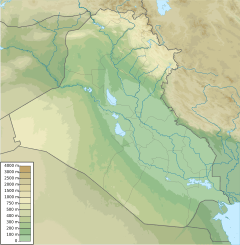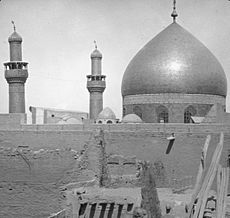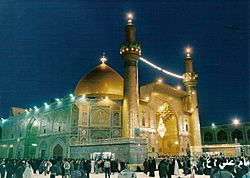Imam Ali Shrine facts for kids
Quick facts for kids Sanctuary of Imam Ali |
|
|---|---|
|
|

Imām 'Alī Mosque, where 'Alī ibn Abī Tālib is buried
|
|
| Religion | |
| Affiliation | Islam |
| Province | Najaf Governorate |
| Rite | Muslims |
| Ecclesiastical or organizational status | Mosque and Shrine |
| Status | Active |
| Location | |
| Location | Najaf |
| Territory | Iraq |
| Architecture | |
| Completed | 977 CE |
| Specifications | |
| Dome(s) | 1 |
| Dome height (inner) | 42 metres (138 ft) |
| Minaret(s) | 2 |
| Minaret height | 38 metres (125 ft) |
| Shrine(s) | 1 |
| Website | |
| https://www.imamali.net | |
The Sanctuary of Imām 'Alī (حَرَم ٱلْإِمَام عَلِيّ), also known as the Mosque of 'Alī (مَسْجِد عَلِيّ), is a very important mosque and shrine. It is located in Najaf, Iraq. Many Muslims believe it holds the tomb of 'Alī ibn Abī Tālib. He was a cousin and son-in-law of the Islamic prophet Muhammad.
Shī'a Muslims see 'Alī as their first Imām, a spiritual leader. Sunni Muslims consider him the fourth Sunni Rashid Caliph, a political and religious leader. Shī'ite belief also states that Adam and Nuh (Noah) are buried here. Every year, millions of people visit this special place to honor Imām 'Alī.
Contents
History of the Sanctuary
The first building over Imām 'Alī's tomb was built in 786. It was created by the Abbasid caliph Harun al-Rashid. This early structure had a green dome.
Later, in 850, another Abbasid caliph, al-Mutawakkil, caused the site to flood. But the shrine was rebuilt in 923 by Abu'l-Hayja. He was a ruler from the Hamdanid dynasty and added a large dome.
In 979–980, the Shi'ite Buyid ruler 'Adud al-Dawla made the shrine much bigger. He added a special monument over the burial site and a new dome. He also put up beautiful textiles and carpets. To protect Najaf, he built a wall and a fortress. He also brought water from the Euphrates River.
Many rulers and leaders continued to improve the shrine over centuries. For example, the Seljuq sultan Malik-Shah I gave many gifts in 1086. The vizier Shams al-Din Juvayni added facilities for visitors in 1267.
A fire damaged the shrine in 1354. However, it was rebuilt around 1358 by the Jalairid sultan Shaikh Awais Jalayir. Later, Timur ordered its restoration. Suleiman the Magnificent also helped restore it in 1534.
Safavid Improvements
The Safavid Shah Ismail I visited in 1508. But it was Abbas I who truly focused on rebuilding the shrine. He visited Najaf twice and hired 500 men to work on it in 1623. His grandson Shah Safi al-Din finished this restoration in 1632. This work included a new dome, a larger courtyard, a hospital, a kitchen, and a guesthouse. These additions helped welcome the many pilgrims.
In 1742, Nader Shah covered the dome and minarets with gold. His wife paid for the walls and courtyard to be rebuilt. She also had new tiles put on the main entrance.
Modern Era Changes
In 1863, the Ottoman emperor Abdülaziz rebuilt two important gates. One was the Clock Portal and the other was the Portal of Muslim Ibn 'Aqil. The Clock Portal was later covered in gold in 1888. This was done by the Qajar sultan Naser al-Din Shah Qajar. In 1886, Sultan Naser al-Din also fixed the dome. It had cracks from the weather.
During a conflict in March 1991, the shrine was damaged. It was then closed for repairs for two years.
Religious Importance
The shrine of Imām 'Alī is very important to Shī'a Muslims. It is the burial site of their second most important figure. Many Shī'a Muslims consider it the fourth holiest Islamic site. It is ranked after Mecca and Medina in Saudi Arabia, and the Al-Aqsa Mosque in Palestine.
It is believed that only Karbala, Mecca, and Medina receive more Muslim pilgrims. A saying from Ja'far as-Sādiq, a respected Shī'ite Imām, calls this site one of "five definitive holy places that we respect very much."
About 8 million pilgrims visit the site each year. This number is expected to grow to 20 million in the future. Many Shī'ites believe that 'Alī wanted his grave to be kept secret. He asked his friends and family to bury him quietly. This secret burial place was later revealed by as-Sādiq. Most Shī'ites agree that 'Alī is buried in the Imām 'Alī Mosque. The city of Najaf grew up around this important shrine.
It is also said that Imām 'Alī Mosque is the third of five holiest Islamic sites. These are Mecca, Medina, Imām 'Alī Mosque in Najaf, Imam Husayn Shrine in Karbalā, and the Shrine of his daughter Fāṭimah in Qom.
Architecture and Design
The Imām 'Alī Mosque is famous for its large, beautiful dome. There are two tall minarets near its main entrance. The big dome is covered with 7777 golden brick slabs. The side and back walls have lovely turquoise mosaics.
You can enter the shrine through three main gates. These are on the eastern, northern, and southern sides. They are called the Main or Clock Portal, al-Tusi Portal, and the Qibla Portal. There are also two other large gates. One is the Portal of Muslim Ibn 'Aqil, and the other is the al-'Amara Portal.
A courtyard surrounds the inner shrine. The inner shrine itself is a large cube with angled corners. It has an onion-shaped dome that is about 42 meters (138 feet) high. On each side of the dome are twin minarets, each about 38 meters (125 feet) tall.
Images for kids
-
Pilgrims during Arba'een in 2015
See also
 In Spanish: Mezquita del Imán Alí para niños
In Spanish: Mezquita del Imán Alí para niños
- Tomb of Noah








